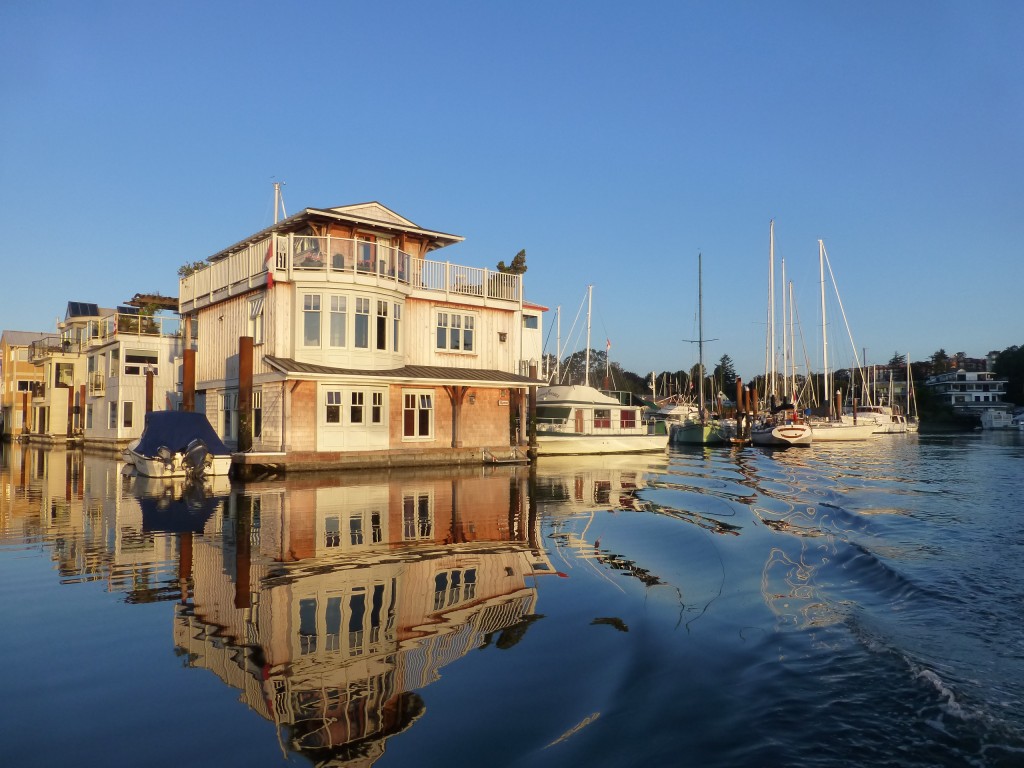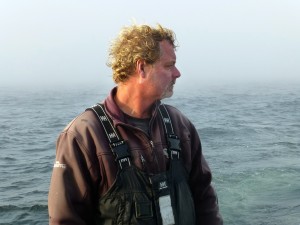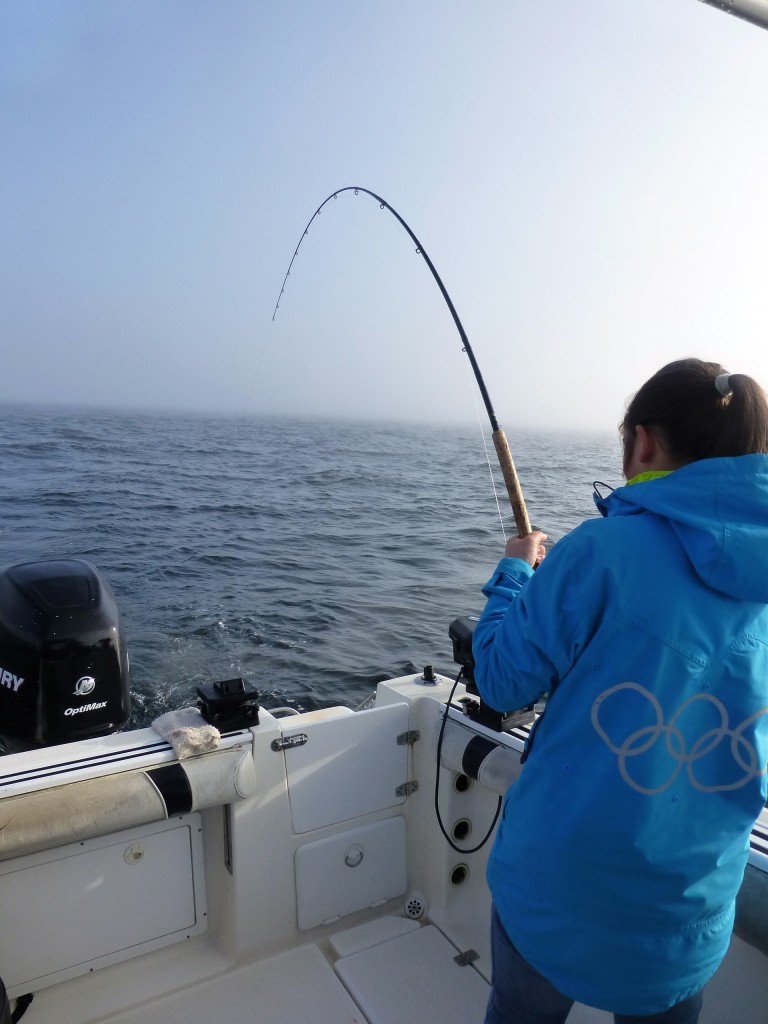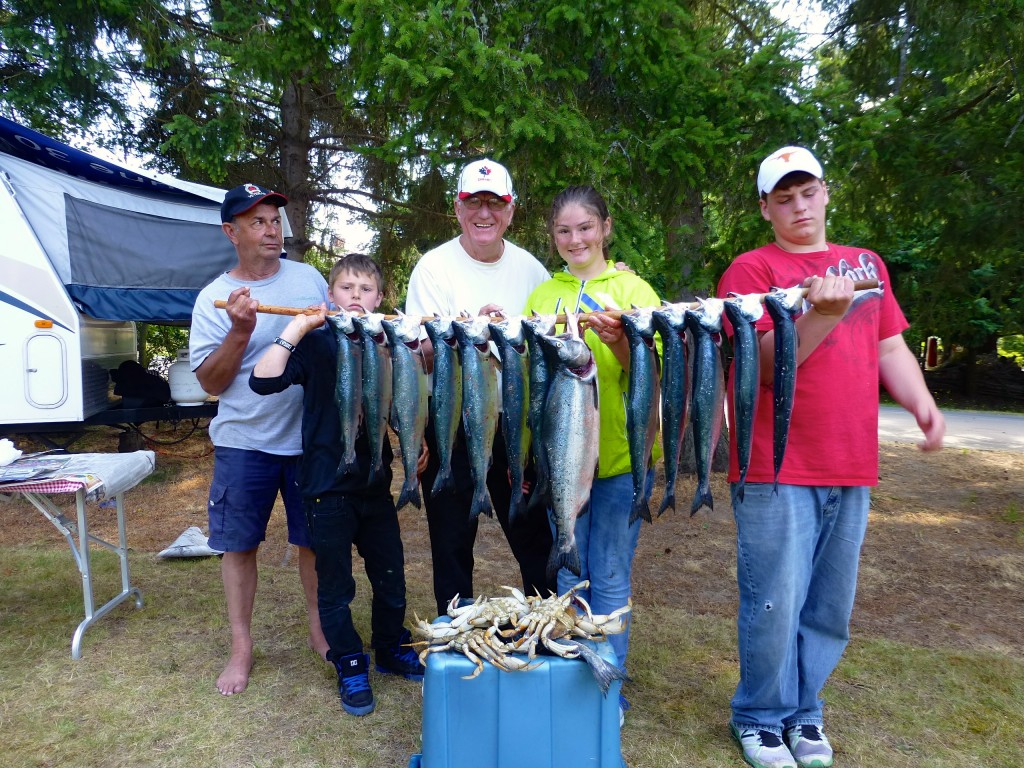A West Coast Fishing Adventure
Barry, Ryan, Harold, Ashley and Ross display their catch of Pink Salmon.
Piled on the blue box is a feed of Dungeness Crabs that were pulled out of the Inner Harbour
Photos of the Fishing Adventure: Link Here
Other Davis Family Victoria Trip Albums
Photos of the City Adventure: Link Here
River and Lake Adventures: Link Here
Ocean Shore and Biking Adventure: Link Here
Victoria Summer Fun Slideshow 2013-Mobile
July 11, 2013 Victoria, BC
While there are many adventures to be found on and around Vancouver Island, a salmon fishing trip on the rolling, fog-shrouded waters of the Strait of Juan de Fuca has to be in the Top 10.
When my brother-in-law, Barry Davis phoned from Spruce Grove, Alberta, to tell us that he, along with his wife, Nancy and three of the grandchildren, Ryan, Ashley and Ross, were heading our way, we were absolutely delighted. As part of our conversation Barry, who is an avid fisherman, wondered if we might squeeze in a few hours of fishing. He felt the “kids” would really enjoy that type of a West Coast experience (he, he).
At the time of their last visit, a couple of decades back (before the Air Force decided to transfer the family to other parts of the world) we rented one of those old, round-bottomed, Brentwood Bay Marina putt-putts that have long since been retired from active service. They were amazing little cabin covered boats with a small two cycle inboard that propelled them along at an amazing five six knots in what was a solid connection to a bygone era of boating in the small bays and inlets of the BC coast.
Back to our current trip, we certainly had no trouble getting the kids up and on the road by 5:15 am. Fifteen minutes after hitting the local Tim Horton’s, we slid into then the Hidden Harbour Marina in Esquimalt, had our single-day fishing licences in hand and were on the water just before 6:00. The first thing that strikes both west coaster and visitor alike, is the pungent odour of salt laden air mixed with a thousand other smells that clearly distinguish both a living and dying ocean ecosystem. It is a totally invigorating smell.
 When we cast off, the perfectly calm, sun-washed waters of West Bay and Victoria’s Inner Harbour, beckoned us toward the historic Strait of Juan de Fuca. With my quick draw camera at the ready, I was able to capture a small measure of the serenity that accompanies of these early morning jaunts under a sun that has just peaked over Mount Baker and the eastern horizon along Washington State.
When we cast off, the perfectly calm, sun-washed waters of West Bay and Victoria’s Inner Harbour, beckoned us toward the historic Strait of Juan de Fuca. With my quick draw camera at the ready, I was able to capture a small measure of the serenity that accompanies of these early morning jaunts under a sun that has just peaked over Mount Baker and the eastern horizon along Washington State.
Fifteen miles to the south, the perpetually fog shrouded base of the Olympic Mountains along the US side of the Strait, brings the mountain peaks into sharp relief that often creates an deceptive illusion as to both their height and distance.
Looking back at the idyllic harbour scene we are about to depart (photo left), made it easy to understand why our long time friends Linda and Bjorn Simonsen along with their daughters, Erika and Kia, spent several years living aboard a float home they had so labouriously constructed in the West Bay. Their former home now sits across the harbour at Fisherman’s Wharf.
While the weather was still dead calm as we set our crab trap in the outer reaches of Victoria’s main harbour, as soon as we hit the Strait, the wind picked up, the inflow of Pacific swells increased and with a swirling tide running opposite to the wind, the chop made it downright rough. More than once we were lifted from our seats as the boat flew from the top of a four-foot roller. It was also a good thing we threw in an extra sweater and jacket as the wind was downright cold.
At first the kids were thrilled with the roller coaster ride out to the fishing area, but after we moved into a shallow fog bank, slowed our speed and the shorelines disappeared, the constant roll of thirty degrees one way and then the other, began to take its toll. While Ross and Ryan conceded to pop a Gravol, Ashley felt she could tough it out, as she disliked the bitter taste. She did well, but a little later in the morning, felt compelled to return a throw a few Timbits back to the fish and crabs. She recovered quickly and was soon back in championship form.
Now a few words about our most excellent guide Gord Martin, owner of Foghorn Fishing Charters. An Island boy, he began his seafaring adventures while still in High School when asked by a school chum to spend a summer commercial fishing with the boy and his father. During that summer Gord so loved the freedom of west coast fishing life style that commercial fishing became his chosen career.
seafaring adventures while still in High School when asked by a school chum to spend a summer commercial fishing with the boy and his father. During that summer Gord so loved the freedom of west coast fishing life style that commercial fishing became his chosen career.
He has now plied these waters for over thirty years and at one time or another has fished for about every type of sea creature that is commercially saleable. His largest catch to date – a 200 pound halibut that took over two hours to extract from the murky depths. Now in his late forties, his curly blond, sun bleached hair and rugged good looks that is strongly accented by his Helly Hanson gear, make him a poster boy for that clothing company and for West Coast fisherman in general.
Poster boy or not, when the time came to begin fishing, his first task was to whip this motley crew of landlubbers into seafaring shape. Precise in his instructions, a bit of Captain Bligh we suppose, he left no room to quibble over the hard and fast rules. First, he did not desire to consign any of us to the Davie Jones locker, as that, he stated, would be bad for business. So when the Captain spoke, we were to listen and respond accordingly.
When a salmon struck, which he said it would within the next thirty minutes, he would grab the rod as the line detached from the down-rigger, give it a strong pull to set the hook, then hand the rod off to the next in line. We would have to listen carefully as he fully expected one or two double headers (two fish on the line at the same time) over the next hour or two.
He explained that pink salmon, which he expected to be in the 6-10 pound range, had very soft mouths and as we were using barbless hooks, the fish could easily cast off the hook if tension on the line was released. To keep up the constant pressure, it was necessary to keep steadily reeling until the fish neared the boat. With between 80 and 100 feet of line between the fish and the boat, this took a bit of time and the fish certainly had other ideas about which direction it would prefer to travel.
Now this might all sound easy, but remember, the boat was still doing its thirty degree tilt as it rose and fell with each passing swell, so maintaining ones balance, as Barry would later attest, was not an easy job. Then came the most critical phase. If you had managed to keep the fish on the line to that point, was bringing it along side to be netted.
Gord told us he would give instructions that we were to follow to a tee: as soon as the flasher cleared the water we were to stop reeling while continuing to raise the rod until the flasher was about four feet off the water. We would then back away from the stern while keeping an even pressure. This would move the fish toward the boat and if all went well, Gord would have the net at ready.
The danger at this point was not so much from losing a fish, but from jerking the hook from the tender mouth of the fish. If that happened, the pressure on the line would cause flasher and hook come flying back across the boat. That, of course, could result in a nasty accident as our Captain would be directly between the person holding the rod and the fish on the other side. Snagging the Captain, Gord warned us, was not a desirable outcome.
With our instructions complete and the hooks, flashers and lines attached, the heavily weighted down-riggers rapidly pulled them to a depth that, over the morning, varied between 55 and 85 feet. Gord then began the process of zeroing in on one of the many schools of pinks that frequented the area. He told us this particular breed of salmon strongly favoured the fast moving waters further out in the Strait near one of the trenches. Using his depth sounder, it was not long before he had us dialled in.
 With the first strike, Ashley was up to bat and as she (and we) would soon learn, even the smaller pinks could put up an able fight as evidenced in gthe photo left. After Ashley set the pace, we were off and running as we continued to transect and zero in on the area of that first strike.
With the first strike, Ashley was up to bat and as she (and we) would soon learn, even the smaller pinks could put up an able fight as evidenced in gthe photo left. After Ashley set the pace, we were off and running as we continued to transect and zero in on the area of that first strike.
Over the next hour, we each took turns reeling in over a half dozen rather good sized salmon and at one point both Ryan and Ross were up to bat with our first double header. The boy’s handled the instructions very well and both fish were safely landed, but on a later double header (Barry and me), both fish managed to elude capture.
On her third turn at bat, Ashley took over a line that clearly held a fish that was much larger than all earlier strikes. When netted and brought on board, it weighed in at just a tad less than nine pounds. Photos of Ashley and her fish are included in the photo album.
A short time later, on his turn, Barry managed to cause a bit of a stir when his fish decided to change sides as it neared the stern of the boat. After managing to clear the propeller (which would have ended in a tangle of fish meat and nylon) Gord managed to snag that elusive little sucker, but not before Barry managed to wham the good Captain in the head a couple of times with the rod. Gord took it all in good stride as we suppose this was not the first time he worked with a number salmon newbies on a rolling ocean.
Shortly after 10:00 am, the fog lifted, the tide changed and the wind began to abate. While the waters were still choppy, it had calmed down rather quickly. As we had neared our limit, Gord suggested we do a little touring around the Race Rocks Lighthouse before heading back to Victoria to check out the crab trap.
While there are often a number of huge Sea Lions sunning themselves on the rocks, I suppose that on this day they, like us, had decided to go fishing. As an example how of how they often occupy these rocks to sun themselves and shoot the breeze, I have included one web shot in the linked photo album. As it was, we were left to view the seals and a lone Bald Eagle surveying his domain. If you have a chance to view the other photo albums, you find that Ashley and Ryan already had a few closeup encounters while feeding them at Fisherman’s Wharf.
As we continued toward Victoria, we noted that a rather large cruise ship had docked. It must have passed us at some point while we happily trolling away in fog the fog. Of course the passing of that ship and many others that transit the Strait, would not present any danger as our fishing area was well outside the designated shipping lanes.
Our final excitement of the day came when raising the trap. It was now filled to capacity with succulent Dungeness crabs. While every under sized crab and all females had to be returned to the harbour waters, we managed to snag four legal sized males of about two pounds each. Those four would nicely compliment the fourteen salmon we had already placed in the hole.
Much to Ashley’s delight, the trap also held one very colourful starfish which both she and Ryan took great delight in inspecting. There was also one Red Rock Crab, a very colourful chap, who gained a free pass back to the ocean depths.
We were joked about how all the little male crabs must be delighted to see those crab traps laying around the harbour knowing full well that after the traps were pulled, all the females would be thrown back in while all the big males would simply disappear. That made things a lot more exciting for those little males as they went about introducing themselves to the ever-increasing population of attractive little Dungeness females.
By early afternoon we were safely back at the McNeill Family Campground situated alongside Leney Place as we busily cleaned our catch and prepared for the farewell dinner for in honour of the Davis Clan. Although I say, “we cleaned the fish”, Barry and I simply gave the kids a few instructions, then kicked back and popped a couple of caps from our secret stash.
Ah, summer, family and fun. Is it not great?
For full set of fishing photos: Link Here
(832)
Trackback from your site.

